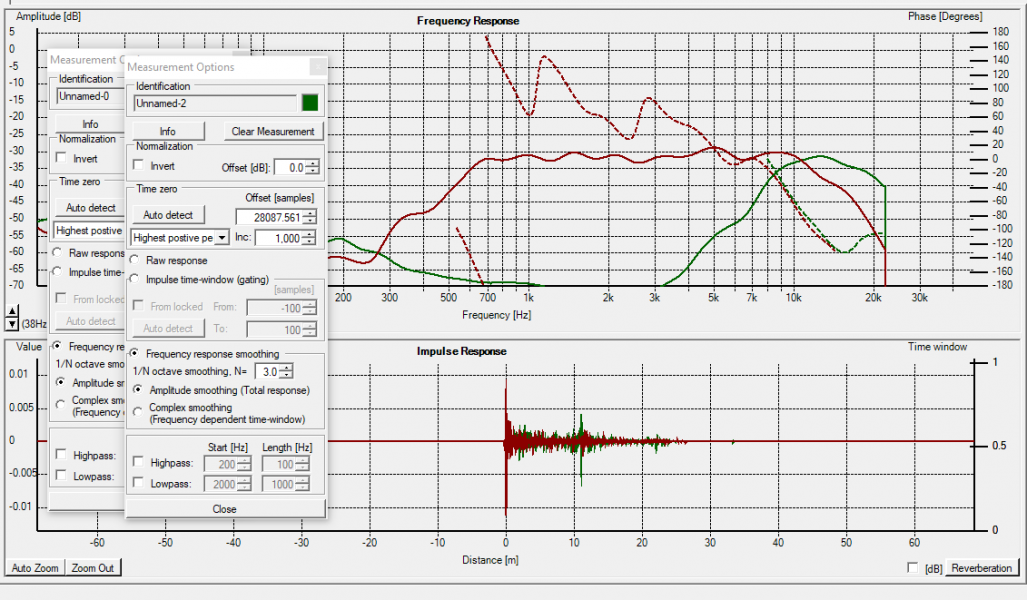WOW! Thank you for for sharing your journey. I haven't had this much fun reading about hifi in a long time. The copious photos are much appreciated.
5 way system, horns and more. From the beginning to now
- Thread starter Multiway
- Start date
You are using an out of date browser. It may not display this or other websites correctly.
You should upgrade or use an alternative browser.
You should upgrade or use an alternative browser.
That's very kind of you to say.WOW! Thank you for for sharing your journey. I haven't had this much fun reading about hifi in a long time. The copious photos are much appreciated.
Have phone camera, will snap
This thread has been a joy to read (and view!).
So many people call hifi a "hobby," when for most of us it's akin to trying different food combinations at a restaurant. You not only cook the food but farm your own ingredients!
You seem to have an excellent balance between the adventure of the journey and the joy of the destination. Much respect!
So many people call hifi a "hobby," when for most of us it's akin to trying different food combinations at a restaurant. You not only cook the food but farm your own ingredients!
You seem to have an excellent balance between the adventure of the journey and the joy of the destination. Much respect!
Hehe, thanks.This thread has been a joy to read (and view!).
So many people call hifi a "hobby," when for most of us it's akin to trying different food combinations at a restaurant. You not only cook the food but farm your own ingredients!
You seem to have an excellent balance between the adventure of the journey and the joy of the destination. Much respect!
It's definitely an adventure.
Sometimes I think, what more can I do, or there's a thread "What do you plan to do to your system this coming year" - often I don't have much at that time but then there's always something I do, sometimes quite large projects, I hadn't forseen..
My system stayed like this for a couple of years.
Tweaks here and there.
I was lucky enough to get a Najda expansion port offering me true 10 output / 5 way control.

This allowed me to get better control of the Raal Lazy Ribbon tweeters and time align them regardless of physical position.
I also explored some different streaming options
Ifi with built in purifier.

Sonore Ultrarendu

I tried these with various power supplies and with / without optical lan (also on linear power).
I then got a Gustard U18 and in conjunction with the Ultrarendu that solution with Qobuz and Bubble Upnp controller (not in the music loop), was the most satisfying sound.
In fact supassing transport and DACs past and present for resolution and right soundingness

I found with Gustard in, with it's galvanic isolation, that the optical lan loop was redundant. Sometimes, less is more.
Next up, the ins and outs of time, phase and physical time alignment
Tweaks here and there.
I was lucky enough to get a Najda expansion port offering me true 10 output / 5 way control.

This allowed me to get better control of the Raal Lazy Ribbon tweeters and time align them regardless of physical position.
I also explored some different streaming options
Ifi with built in purifier.

Sonore Ultrarendu

I tried these with various power supplies and with / without optical lan (also on linear power).
I then got a Gustard U18 and in conjunction with the Ultrarendu that solution with Qobuz and Bubble Upnp controller (not in the music loop), was the most satisfying sound.
In fact supassing transport and DACs past and present for resolution and right soundingness

I found with Gustard in, with it's galvanic isolation, that the optical lan loop was redundant. Sometimes, less is more.
Next up, the ins and outs of time, phase and physical time alignment
The next thing I dabbled with was horn mouth alignment!
This can only be reasonably done with DSP!
It involves accurately measuring the distance from the drivers diaphragm to the horn mouth edge, and removing the time sound takes to travel that path in milliseconds from the normal time alignment delay.
This means the sound eminates from the horn mouths and merges / interacts with the room in alignment, rather than from the diaphragms and is jumbled up by the different horn lengths.
Schematic (picture with a thousand words)
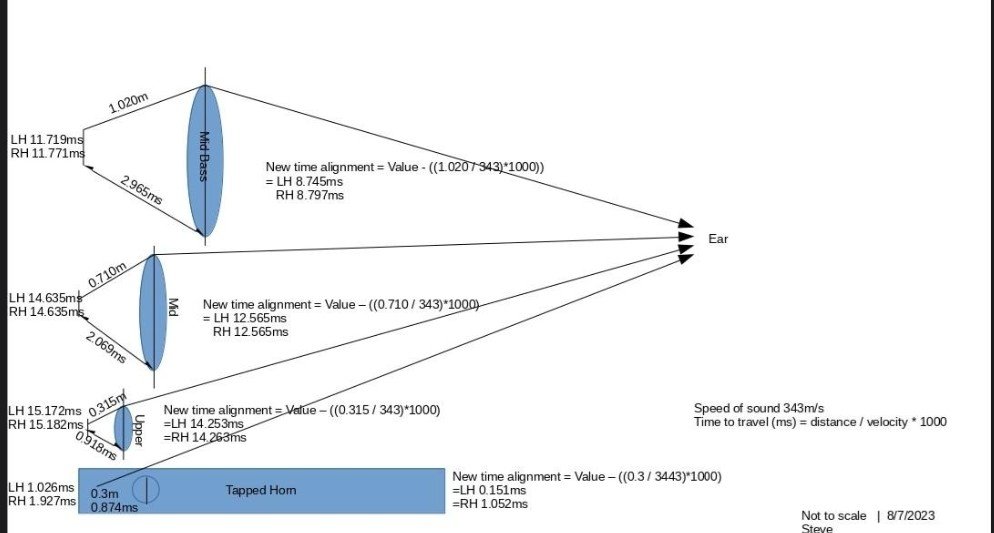
This gave a more interesting presentation to the sound.
Switching between the two alignment methods, very stark difference.
I preferred the mouth adjusted set up, this was proved over long term listening too.
I then physically aligned the mouths of all the horns.
This is to reduce reflections from the backs of the other horns and give mouth alignment an even better lookin.
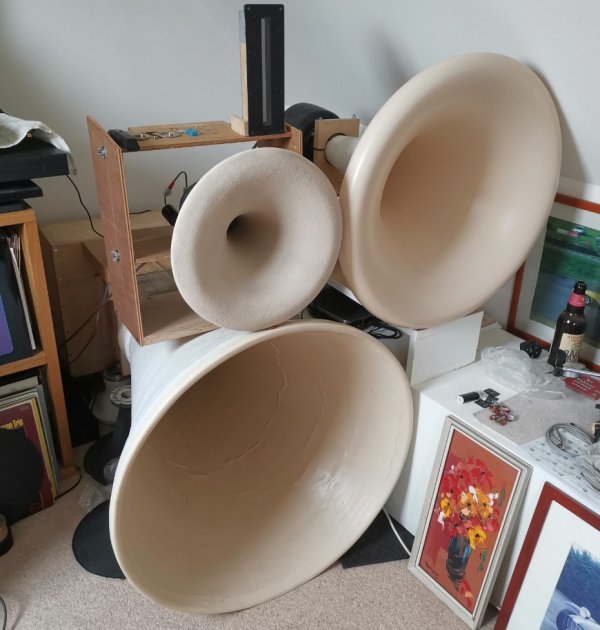
Time and other alignments with the horns like this can ONLY be done using DSP.
First I normal time aligned. Listened - meh!
Then added the diaphragm to mouth adjustment. Hmm has legs..
Next up, proper phase alignment
This can only be reasonably done with DSP!
It involves accurately measuring the distance from the drivers diaphragm to the horn mouth edge, and removing the time sound takes to travel that path in milliseconds from the normal time alignment delay.
This means the sound eminates from the horn mouths and merges / interacts with the room in alignment, rather than from the diaphragms and is jumbled up by the different horn lengths.
Schematic (picture with a thousand words)

This gave a more interesting presentation to the sound.
Switching between the two alignment methods, very stark difference.
I preferred the mouth adjusted set up, this was proved over long term listening too.
I then physically aligned the mouths of all the horns.
This is to reduce reflections from the backs of the other horns and give mouth alignment an even better lookin.

Time and other alignments with the horns like this can ONLY be done using DSP.
First I normal time aligned. Listened - meh!
Then added the diaphragm to mouth adjustment. Hmm has legs..
Next up, proper phase alignment
Last edited:
All distances should be from the diaphragm and not the horn mouth as that is the actual source of the sound.The next thing I dabbled with was horn mouth alignment!
This can only be reasonably done with DSP!
It involves accurately measuring the distance from the drivers diaphragm to the horn mouth edge, and removing the time sound takes to travel that path in milliseconds from the normal time alignment delay.
This means the sound eminates from the horn mouths and merges / interacts with the room in alignment, rather than from the diaphragms and is jumbled up by the different horn lengths.
Schematic (picture with a thousand words)
View attachment 125268
This gave a more interesting presentation to the sound.
Switching between the two alignment methods, very stark difference.
I preferred the mouth adjusted set up, this was proved over long term listening too.
I then physically aligned the mouths of all the horns.
This is to reduce reflections from the backs of the other horns and give mouth alignment an even better lookin.
View attachment 125269
Time and other alignments with the horns like this can ONLY be done using DSP.
First I normal time aligned. Listened - meh!
Then added the diaphragm to mouth adjustment. Hmm has legs..
Next up, proper phase alignment
Yeah that's the trad thinking.All distances should be from the diaphragm and not the horn mouth as that is the actual source of the sound.
Also this is not simple distance from the mouth.
It's alignment minus the speed of sound from diaphragm to mouth.
Horn mouth alignment is a thing, believe it
I spoke to a well respected engineer friend with huge audio experience back then, as I got the idea from DIYaudio.
He said;
"The mouth alignment is interesting as basically the way a horn works is to create a virtual driver made of air at the horn mouth (well, sort of). Obviously you do have to compensate for path length using time delay. So it does make sense to me. It will definitely behave differently in terms of off axis responses as the reflection points will be different with big horns and overall directivity pattern will change."
Last edited:
Rommy
Romy the Cat would disagree regarding DSP:The next thing I dabbled with was horn mouth alignment!
This can only be reasonably done with DSP!
It involves accurately measuring the distance from the drivers diaphragm to the horn mouth edge, and removing the time sound takes to travel that path in milliseconds from the normal time alignment delay.
This means the sound eminates from the horn mouths and merges / interacts with the room in alignment, rather than from the diaphragms and is jumbled up by the different horn lengths.
Schematic (picture with a thousand words)
View attachment 125268
This gave a more interesting presentation to the sound.
Switching between the two alignment methods, very stark difference.
I preferred the mouth adjusted set up, this was proved over long term listening too.
I then physically aligned the mouths of all the horns.
This is to reduce reflections from the backs of the other horns and give mouth alignment an even better lookin.
View attachment 125269
Time and other alignments with the horns like this can ONLY be done using DSP.
First I normal time aligned. Listened - meh!
Then added the diaphragm to mouth adjustment. Hmm has legs..
Next up, proper phase alignment
Romy the Cat's Macondo Acoustic System
GoodSoundClub - Romy the Cat's personal High-End Audio site
www.goodsoundclub.com
Romy is not hereRommy
Romy the Cat would disagree regarding DSP:
Romy the Cat's Macondo Acoustic System
GoodSoundClub - Romy the Cat's personal High-End Audio sitewww.goodsoundclub.com
Edit : how without DSP would you physically align the horn mouths (they are all close to each other and flush distance wise). The drivers are then at all different distances from each other due to the different horn lengths + the tapped horn subs are some 12ms behind the others too).
You couldn't then time / phase align the diaphragms etc without DSP - could you?
Maybe there is some time warping analogue gizmo I'm not aware of?
Last edited:
Having had my interest peaked by different alignment giving different balance and sound, egged on by a learned few on DIYaudio who were most helpful, I changed the alignment to phase alignment.
I first ensure the most hearing critical upper mid drivers are aligned left and right.
Here's the procedure for phase aligning say HF horn or tweeter to the Mid Range driver.
I find it best to time align the drivers first do they are thereabouts and then do the phase alignment procedure.
This is the procedure I follow using the excellent Holmimpulse tool. I'm sure others are good too..
> Mic at the listening positon (orientation is not important for this work)
> I always use the 'log sine sweep' signal, but it probably does not matter which is used. I think the sweep will provide a little more S/N ratio, but again I don't expect a need for that.
> Activate all XO's.
> All measurements should be full range.
> Activate 'Time zero locked' (Data Analysis tab)
> Activate 'Keep stream active' (Device & Signal tab)
> Select 'Restart stream'
> Measure the HF horn frequency (Measurements tab)
> Under options for that measurement, Select 'Auto Detect' (a couple times is fine - not critical)
> Copy the 'Offset (Samples)' value and paste it into the 'Locked offset (samples) box (under Data Analysis tab).
> Zoom in on the Impulse Response as you did above to confirm the IR peak is located near 0ms.
> Select "measure" again using the same memory location to assure that the IR location is repeated. We should be able to repeat that measurement several times with always the same result. If the IR position changes away from 0ms there is a problem with the time lock and we need to troubleshoot. It is normal that the IR location may change if the stream is restarted so when the IR is stable near 0ms do not restart the stream.
> Measure the MR Horn using a different memory location.
> Save the file.
The rest of the work is done within Holmimpulse.
> Turn off SPL traces but note the X/O frequency range and turn on only the Phase traces.
> Smooth both traces 1/3 octave.
> Adjust the Offset (delay) of the MR Horn as needed to achieve close phase tracking of the direct sound throughout the XO range. (Expect a very clean phase trace in this case but sometimes, particularly when XO <500Hz, there can be room modes or reflections that make phase chart more difficult to properly interpret)
> Then reduce the smoothing to 1/6 or 1/9 and sometimes make a minor adjustment to the tracking (delay) when more phase detail is being shown.
> We may find better tracking with the MR horn's polarity reversed (esp if 2nd order XO is used).
> Now we have a new value in the MR Horn offset box.
The difference in samples between and the new and the original value can be converted to time and that represents the delay change that is needed to input into your DSP, or physically moving the driver if not using DSP.
> I then remeasure the MR horn with the new values in, to confirm everything is as it should be.
(Taken from a DIYaudio Holmimpulse thread and modded to suit).
I've not personally found below 500Hz a challenge.
The mid bass to tapped horn 100Hz XO gives nice traces.
Same for the MR to mid bass horns at 300Hz.
I can thoroughly recommend anyone who can do this procedure on a multi way system.
Passive radiating drivers offer more of a challenge apparently (I've not done them myself though).
The reason is more room reflections play in than with horn systems, thus complicating the phase plots - esp in smaller rooms.
One thing I found was examining the phase plots between the different drivers gave me cause to re-examine the slopes and ensure they were similar / compatible.
A 4th order on one driver and a 2nd order on the adjacent driver may well not have nice aligned phase plots throughout the X/O region. The alignment will not be overlapping / in sync.
I changed two X/Os because if this.
I'm speculating -
Measuring in free space garden or anechoic chamber would solve that, but then you ha
ve to simulate the room's listening distances.
Here are my attempts.
I'm still evaluation and refining this.
Tapped horn to mid bass.
X/O 100Hz - phase plots follow each other quite closely, once adjusted.
Note extra bass at 27Hz room mode.
I have 3 settings from this to flat. This one is 'shock and awe' setting when demoing bass. Sofa vibrates nicely to church and cathedral bass, and certain electronical.
Flat is totally boring!
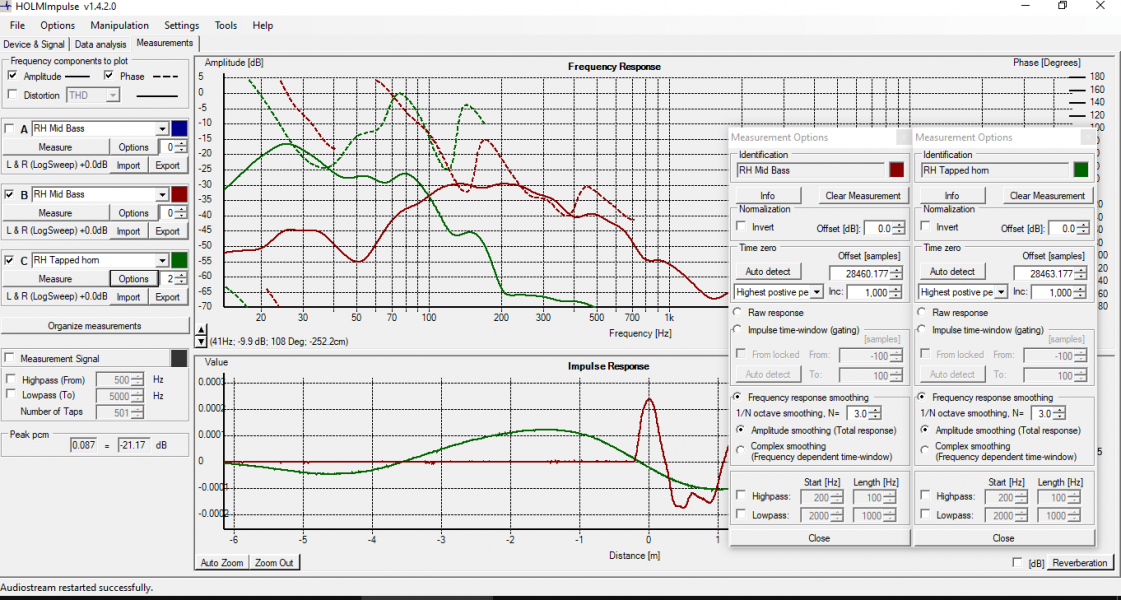
Mid bass to mid. 300Hz crossover.
Phase plots pretty much overlap.
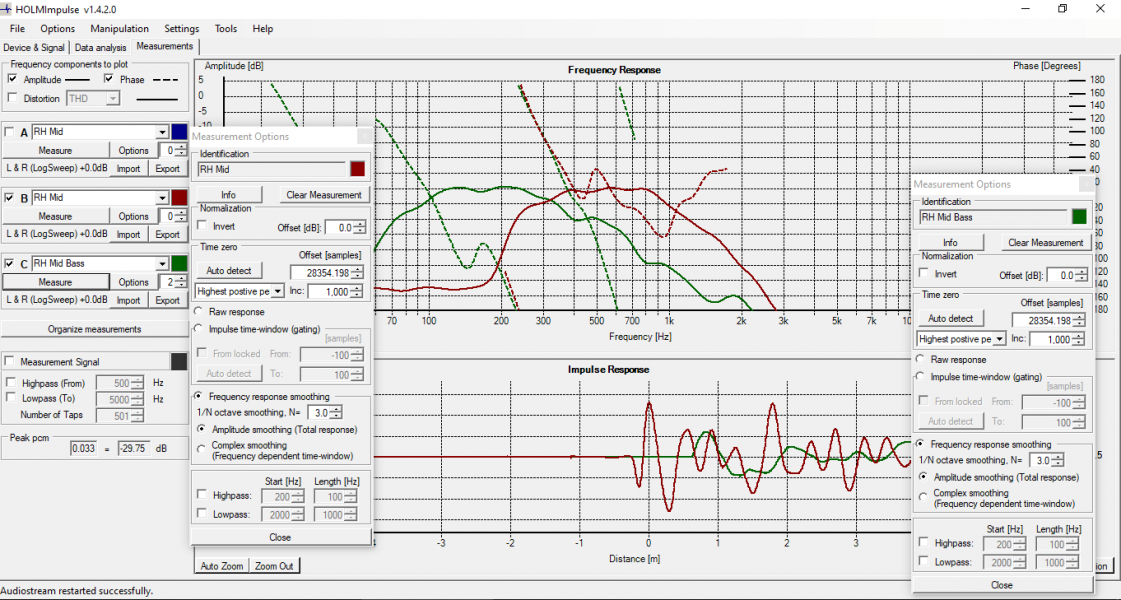
Mid to upper mid crossover 800Hz. Phase plots overlap quite well once adjusted.
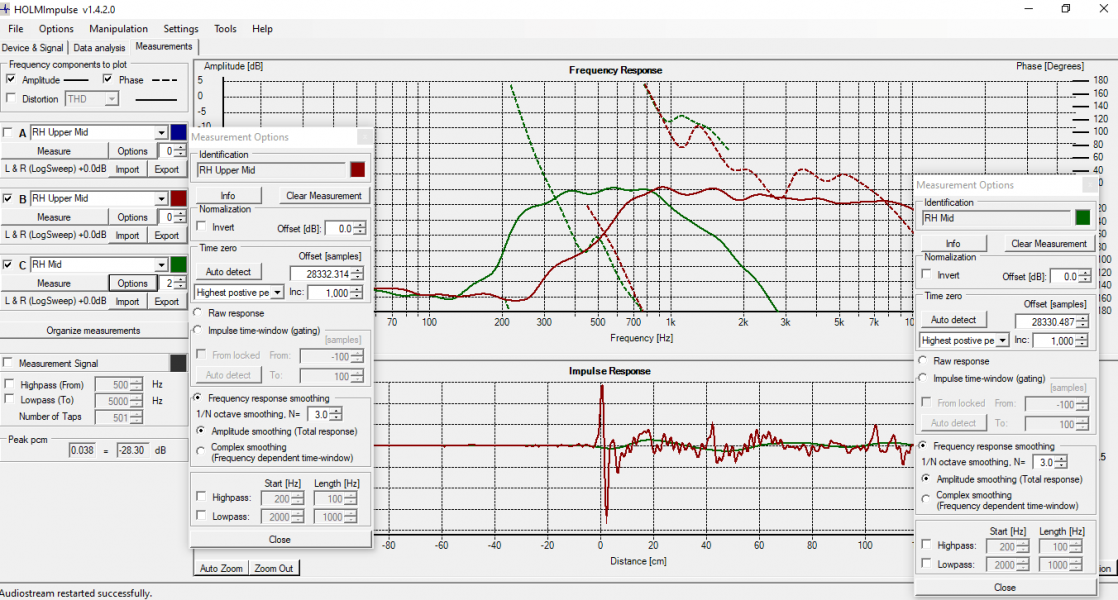
I've yet to take a snapshot of the upper mid to tweeter plots.
This method of alignment gives the most integrated, balanced and right sound I've achieved.
If any readers have more insight into how to do this, it would be most welcome.
I've not tried importing the plots into vituixcad yet. It's on my to-do list.
I first ensure the most hearing critical upper mid drivers are aligned left and right.
Here's the procedure for phase aligning say HF horn or tweeter to the Mid Range driver.
I find it best to time align the drivers first do they are thereabouts and then do the phase alignment procedure.
This is the procedure I follow using the excellent Holmimpulse tool. I'm sure others are good too..
> Mic at the listening positon (orientation is not important for this work)
> I always use the 'log sine sweep' signal, but it probably does not matter which is used. I think the sweep will provide a little more S/N ratio, but again I don't expect a need for that.
> Activate all XO's.
> All measurements should be full range.
> Activate 'Time zero locked' (Data Analysis tab)
> Activate 'Keep stream active' (Device & Signal tab)
> Select 'Restart stream'
> Measure the HF horn frequency (Measurements tab)
> Under options for that measurement, Select 'Auto Detect' (a couple times is fine - not critical)
> Copy the 'Offset (Samples)' value and paste it into the 'Locked offset (samples) box (under Data Analysis tab).
> Zoom in on the Impulse Response as you did above to confirm the IR peak is located near 0ms.
> Select "measure" again using the same memory location to assure that the IR location is repeated. We should be able to repeat that measurement several times with always the same result. If the IR position changes away from 0ms there is a problem with the time lock and we need to troubleshoot. It is normal that the IR location may change if the stream is restarted so when the IR is stable near 0ms do not restart the stream.
> Measure the MR Horn using a different memory location.
> Save the file.
The rest of the work is done within Holmimpulse.
> Turn off SPL traces but note the X/O frequency range and turn on only the Phase traces.
> Smooth both traces 1/3 octave.
> Adjust the Offset (delay) of the MR Horn as needed to achieve close phase tracking of the direct sound throughout the XO range. (Expect a very clean phase trace in this case but sometimes, particularly when XO <500Hz, there can be room modes or reflections that make phase chart more difficult to properly interpret)
> Then reduce the smoothing to 1/6 or 1/9 and sometimes make a minor adjustment to the tracking (delay) when more phase detail is being shown.
> We may find better tracking with the MR horn's polarity reversed (esp if 2nd order XO is used).
> Now we have a new value in the MR Horn offset box.
The difference in samples between and the new and the original value can be converted to time and that represents the delay change that is needed to input into your DSP, or physically moving the driver if not using DSP.
> I then remeasure the MR horn with the new values in, to confirm everything is as it should be.
(Taken from a DIYaudio Holmimpulse thread and modded to suit).
I've not personally found below 500Hz a challenge.
The mid bass to tapped horn 100Hz XO gives nice traces.
Same for the MR to mid bass horns at 300Hz.
I can thoroughly recommend anyone who can do this procedure on a multi way system.
Passive radiating drivers offer more of a challenge apparently (I've not done them myself though).
The reason is more room reflections play in than with horn systems, thus complicating the phase plots - esp in smaller rooms.
One thing I found was examining the phase plots between the different drivers gave me cause to re-examine the slopes and ensure they were similar / compatible.
A 4th order on one driver and a 2nd order on the adjacent driver may well not have nice aligned phase plots throughout the X/O region. The alignment will not be overlapping / in sync.
I changed two X/Os because if this.
I'm speculating -
Measuring in free space garden or anechoic chamber would solve that, but then you ha
ve to simulate the room's listening distances.
Here are my attempts.
I'm still evaluation and refining this.
Tapped horn to mid bass.
X/O 100Hz - phase plots follow each other quite closely, once adjusted.
Note extra bass at 27Hz room mode.
I have 3 settings from this to flat. This one is 'shock and awe' setting when demoing bass. Sofa vibrates nicely to church and cathedral bass, and certain electronical.
Flat is totally boring!

Mid bass to mid. 300Hz crossover.
Phase plots pretty much overlap.

Mid to upper mid crossover 800Hz. Phase plots overlap quite well once adjusted.

I've yet to take a snapshot of the upper mid to tweeter plots.
This method of alignment gives the most integrated, balanced and right sound I've achieved.
If any readers have more insight into how to do this, it would be most welcome.
I've not tried importing the plots into vituixcad yet. It's on my to-do list.
Last edited:
I also tried various forms of room treatment.
I don't have room in the corners for big bass traps and don't really have an issue with the bass - once I've corrected at 30Hz and 70Hz, applied in DSP.
No other correction elsewhere.
It's not a clappy room by any means.
I did find that 1000Hz up treatment gave a much shaper image, esp vocals.
I tried thicker 500Hz and up panels but didn't like the effect so much.
To find the positioning I used the line of sight mirror trick.
It's not so obvious what is reflecting where, in a loft room and to the listening spot.
I have around 20% coverage excluding carpet etc.
Side ceiling, also end wall.
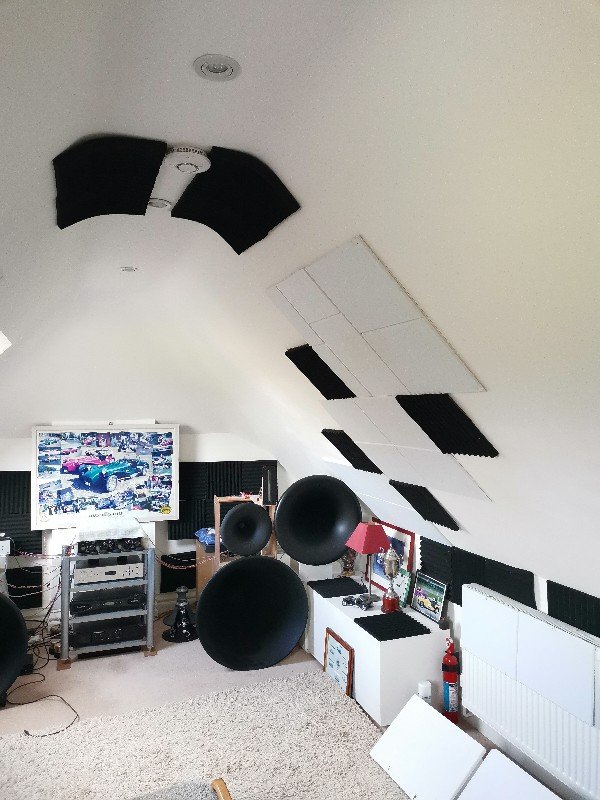
More behind the listening spot and to the sides (not in shot).
Really happy with the sound.
I don't have room in the corners for big bass traps and don't really have an issue with the bass - once I've corrected at 30Hz and 70Hz, applied in DSP.
No other correction elsewhere.
It's not a clappy room by any means.
I did find that 1000Hz up treatment gave a much shaper image, esp vocals.
I tried thicker 500Hz and up panels but didn't like the effect so much.
To find the positioning I used the line of sight mirror trick.
It's not so obvious what is reflecting where, in a loft room and to the listening spot.
I have around 20% coverage excluding carpet etc.
Side ceiling, also end wall.

More behind the listening spot and to the sides (not in shot).
Really happy with the sound.
Last edited:
Great audio journey and great dedication, thanks for sharing 
I've been through the whole journey myself, big DIY active horn rig, horn subs, DSP, EQ, room acoustics, the lot. When you get it right, it delivers great sound quality second to none.
Regarding the time alignment, you will only have true time alignment using FIR filter and still, it is very difficult (impossible) to achieve with a big horn rig, with drivers having large center to center distance. Using 2. order x-over filters or higher order, will give phase rotation and impairing the true time alignment, as well. Using phase summation, that will only happen on one axis, at one distance and in one point in space. A step response plot will show the exact alignment between the different drivers. Not sure Holm Impulse can show step response, but REW can.
So for all practical reasons, I believe that you are chasing the rabbit.
I've been through the whole journey myself, big DIY active horn rig, horn subs, DSP, EQ, room acoustics, the lot. When you get it right, it delivers great sound quality second to none.
Regarding the time alignment, you will only have true time alignment using FIR filter and still, it is very difficult (impossible) to achieve with a big horn rig, with drivers having large center to center distance. Using 2. order x-over filters or higher order, will give phase rotation and impairing the true time alignment, as well. Using phase summation, that will only happen on one axis, at one distance and in one point in space. A step response plot will show the exact alignment between the different drivers. Not sure Holm Impulse can show step response, but REW can.
So for all practical reasons, I believe that you are chasing the rabbit.
Definitely chasing.
My DSP doesn't have the horsepower for low freq FIR.
I've been enjoying doing a Danley SH-50 DIY build recently and some hybrid trials.
I must write that up here..
My DSP doesn't have the horsepower for low freq FIR.
I've been enjoying doing a Danley SH-50 DIY build recently and some hybrid trials.
I must write that up here..
RIP the big mid bass horns.
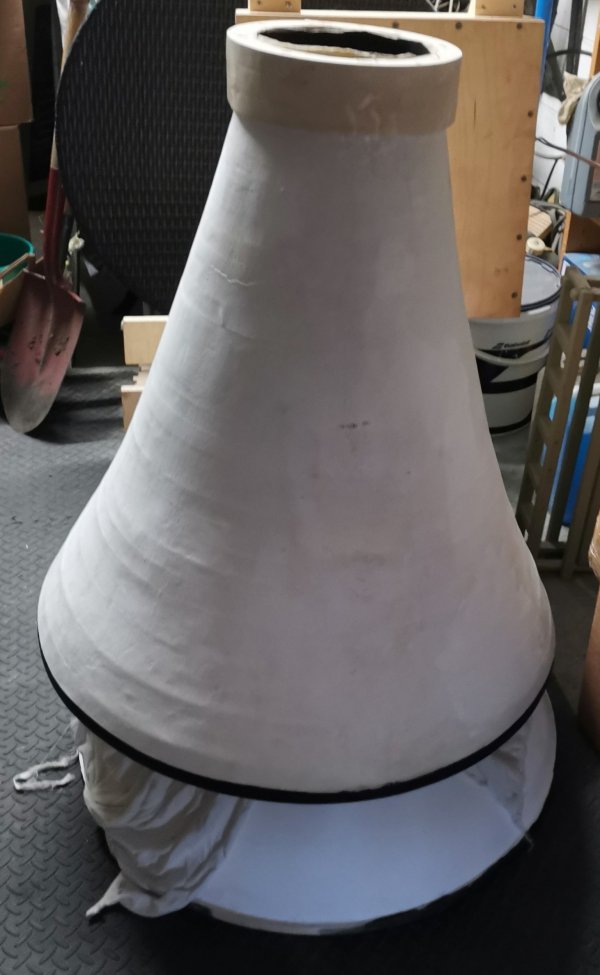
Once powered by the Eminence Kappa 15As, trialled with Vitavox 15", JBL 15" drivers, then extended and used for years with Eminence Kappa 12As.
Now out in temp storage, on their way to either a new home (unlikely), or the skip.
Had them in one shape out form these 11 years passed!
The Synergy system is too compelling
Never going back.
The hifi journey continues with the Synergy build and no doubt further evolution

Once powered by the Eminence Kappa 15As, trialled with Vitavox 15", JBL 15" drivers, then extended and used for years with Eminence Kappa 12As.
Now out in temp storage, on their way to either a new home (unlikely), or the skip.
Had them in one shape out form these 11 years passed!
The Synergy system is too compelling
Never going back.
The hifi journey continues with the Synergy build and no doubt further evolution
Thanks - Its a great hobby.Multiway, my hat is off to you. Your intelligence, skill, craftsmanship and tenacity are off the chart awesome.
That's very kind of you to say.
Have phone camera, will snap
Having only heard this horn
https://josephcrowe.com/products/3d-cad-files-horn-no-1994-es450-biradial-for-jbl-2446-2-throat
https://josephcrowe.com/blogs/news/es-450-biradial-no-2143
in a system with the B&C DCM50 midrange and a Fostex T96A tweeter in this waveguide
https://josephcrowe.com/blogs/news/lens-no-1896-for-fostex-t96a?_pos=2&_sid=8054c5b96&_ss=r
, I’m troubled trying to decide between that horn and the JMLC AH425, which some at diyaudio.com have argued I should have Troy Crowe build for me instead, if partially because I happen to own a pair of those undrilled horns, though my budget is large as I’ve been saving for years.
Presumably, the narrowing directivity patterns of both horns are similar.
https://cdn.shopify.com/s/files/1/0...ot_2023-10-14_170306_480x480.png?v=1697317415
But might the ES-450’s vertical response likely be wider than the AH425 below 1kHz though narrower at 10kHz?
And while having a mere ~ 4 ft sweet spot, would the 425 horn offer superior imaging and vertical spaciousness?
With a wider sweet spot would not the ES450 deliver horizontal spaciousness?
What other sonic differences might you expect between these horns?
How to decide??
Similar threads
- Replies
- 30
- Views
- 10K
- Replies
- 85
- Views
- 16K
- Replies
- 7
- Views
- 4K
- Replies
- 67
- Views
- 29K
- Replies
- 1K
- Views
- 206K
| Steve Williams Site Founder | Site Owner | Administrator | Ron Resnick Site Owner | Administrator | Julian (The Fixer) Website Build | Marketing Managersing |


